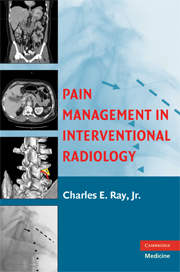Book contents
- Frontmatter
- Contents
- Contributors
- Preface
- Acknowledgments
- 1 Pain Management in Interventional Radiology: An Introduction
- 2 Clinical Evaluation of Low-Back Pain
- PART I LOCOREGIONAL PAIN CONTROL
- PART II SYSTEMIC PAIN CONTROL
- 16 Sedation and Analgesia Medications
- 17 Guidelines for Sedation Administered by Nonanesthesiologists
- 18 Pediatric Sedation for Radiological Imaging Studies and Interventions
- 19 Nontraditional Pain Management in Interventional Radiology
- 20 Postprocedural Pain Control
- Index
- References
20 - Postprocedural Pain Control
from PART II - SYSTEMIC PAIN CONTROL
Published online by Cambridge University Press: 04 September 2009
- Frontmatter
- Contents
- Contributors
- Preface
- Acknowledgments
- 1 Pain Management in Interventional Radiology: An Introduction
- 2 Clinical Evaluation of Low-Back Pain
- PART I LOCOREGIONAL PAIN CONTROL
- PART II SYSTEMIC PAIN CONTROL
- 16 Sedation and Analgesia Medications
- 17 Guidelines for Sedation Administered by Nonanesthesiologists
- 18 Pediatric Sedation for Radiological Imaging Studies and Interventions
- 19 Nontraditional Pain Management in Interventional Radiology
- 20 Postprocedural Pain Control
- Index
- References
Summary
INTRODUCTION
A sound knowledge of postprocedural pain control is essential as interventional radiologists take the lead in managing their patients and as interventional radiology continues to grow as a clinical service. Not only do patients deserve to receive adequate postprocedural pain management but also regulatory and other quality control bodies, such as the Joint Commission on Accreditation of Healthcare Organizations (1) and at least one medical malpractice insurance carrier (2), critically evaluate a practitioner's and hospital plan for pain control after a procedure.
Postprocedural pain is clearly an important issue for interventional radiology and in medicine in general. Consider that in a sample of 250 patients who had recently had surgery, 80% of patients actually experienced acute postoperative pain, 86% of these patients had moderate-to-extreme pain, and 59% cited experiencing postoperative pain as their most common concern (3). Specifically concerning interventional radiology, many multicenter trials examining uterine fibroid embolization (UFE) have found postprocedural pain the most common side effect after the procedure (4) and inadequate pain relief as the most common adverse event after discharge necessitating readmission (5,6,7).
This chapter will review the management of postprocedural pain. A brief summary of the physiological mechanism of pain will be followed by a general treatment strategy, a review of pertinent medications and different techniques for pain control, and then an examination of postprocedural pain strategies for specific procedures, namely, UFE, transarterial hepatic chemoembolization, percutaneous biliary procedures, and various other procedures.
- Type
- Chapter
- Information
- Pain Management in Interventional Radiology , pp. 296 - 314Publisher: Cambridge University PressPrint publication year: 2008



